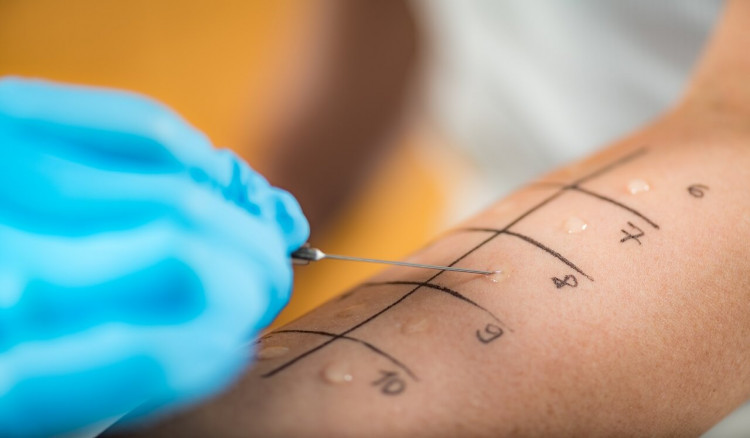
Diabetes Insulin Allergy
With so many people turning to human insulin, insulin allergy is becoming less and less common. However, some people may still experience an allergic response to an insulin preparation. Insulin allergies can be local (confined to the area around the injection site) or systemic (affecting the whole body).
If you do have an allergic reaction, you may be allergic to the insulin itself or to ingredients used in the insulin preparation, such as the protamine in NPH or the zinc used in lente insulins. And what may appear to be local allergic reaction may really be due to an improper injection technique. It is important to consult with your health care team to figure out the source of your allergy.
[If you are not sure you have diabetes or you want to know if you already have diabetes, use this diabetes symptoms tool to check]
DIABETES INSULIN ALLERGY SYMPTOMS
Burning, itching, redness, swelling, hives or rash at the insulin injection site could indicate a local allergic reaction. Depending on the cause of the allergic reaction, symptoms can occur within 30 minutes after injection or over the course of several hours.
Delayed allergic reaction may appear over the course of 24 hours. In rare cases, insulin can trigger a severe asthmatic or anaphylactic response, due to a systemic allergy. These symptoms, which occur within minutes, include difficulty in breathing, respiratory distress, vomiting, abdominal distress, and even shock. However, this response is extremely rare, especially with the wide use of human insulin
DIABETES INSULIN ALLERGY RISK
Insulin allergies are usually local and systemic responses are very rare. You are more likely to have an insulin allergy if you are allergic to penicillin or have a history of other allergies, have been on insulin intermittently or are overweight. Local insulin allergies are not life-threatening and usually clear up on their own after a few months. However, in rare cases, a life-threatening systemic allergic reaction can occur.
What You Should Do
Local allergic responses usually appear during the first 2 weeks of therapy and clear up on their own within a month or two. Make sure you are injecting insulin properly and that your cleansing alcohol contains no contaminants. Also make sure that there are no signs of infection (extreme tenderness and redness, pus formation or anything that oozes) at the injection site. If there is an infection you may need to be treated with an antibacterial agent.
If your symptoms are mild and produce only minor discomfort, you may want to just wait it out and see if the allergy clears up on its own. However, if the allergic reaction persists for more than a month and is making you uncomfortable, talk to your doctor about what steps to take. You may want to switch to human insulin if you have not already done so. If you see no improvement in 2 to 14 doses, your doctor may conduct a skin test to see which insulin preparations are least reactive. You may be advised to switch to the least reactive form of insulin. If you continue to have persistent, severe allergy to the least reactive insulin, your doctor may recommend treatment by insulin desensitization. You may also want to be tested for an allergy to zinc, protamine, preservatives or the rubber stopper used to cap the insulin vial.
If you have a general or systemic reaction to insulin, call your doctor right away or seek emergency medical treatment if your symptoms are severe. These symptoms include loss of color, clamminess of the skin, a drop in blood pressure, rapid but weak pulse, restlessness, difficulty breathing, anxiety and sometimes unconsciousness. If you have type 2 diabetes, your doctor may want to discontinue insulin and treat you with an aggressive low-calorie diet, exercise and oral agents. If you have type 1 diabetes and require insulin, you will need to be desensitized in a hospital setting
DIABETES INSULIN ALLERGY TREATMENT
If you require insulin and are having a general or systemic insulin reaction, you will need to be treated in an intensive care unit that is prepared to deal with anaphylactic shock. After skin testing for the least reactive insulin, you will need to undergo insulin desensitization. If you are having a local insulin allergic reaction, you may still need to undergo desensitization, but will probably not require hospitalization.
To do this, you will be given low doses of the least reactive insulin at periodic interval. The dose of insulin will be increased until you receive 1 unit of insulin or until a skin reaction occurs. If a skin reaction occurs, the dose will be dropped and again increased at periodic intervals until plasma glucose is under satisfactory control. You may be given a dose of steroid or antihistamine if desensitization is not occurring. The amount of insulin will then be increased until you can tolerate a therapeutic level of insulin without an allergic reaction.
Check any other diabetes symptoms you may have and get treatment solutions by using our free diabetes symptoms checker tool
Sources and References
- The Diabetes Problem Solver—Quick Answers to Your Questions About Treatment and Self-Care by Nancy Touchette
- Insulin Allergy by Mohammad Ghazavi and Graham Johnston
- Insulin Allergy: Clinical Manifestations and Management Strategies by L Heinzerling, K Raile et al






Share This Article: